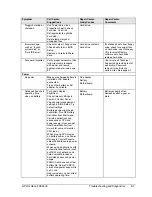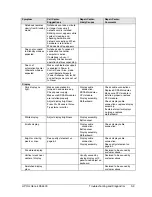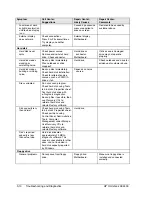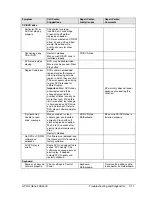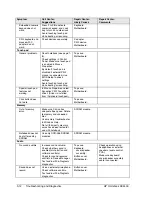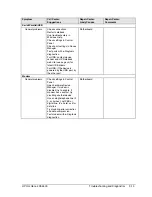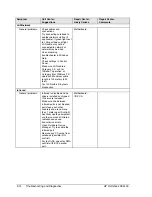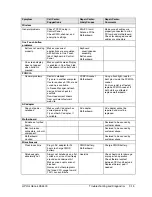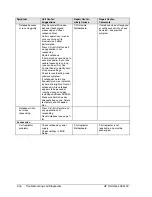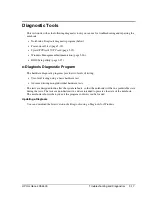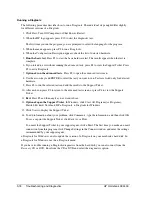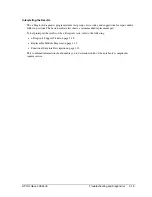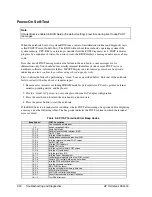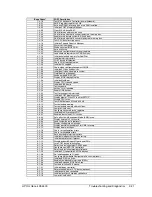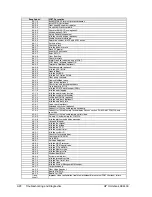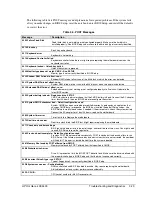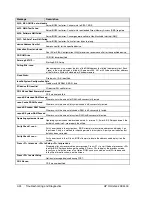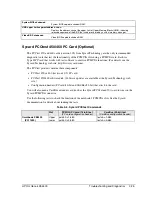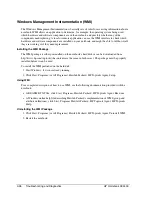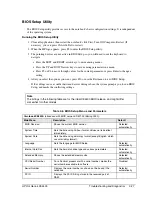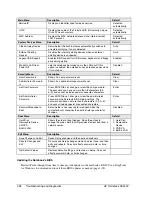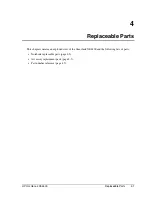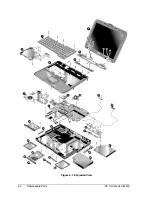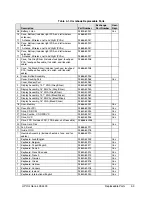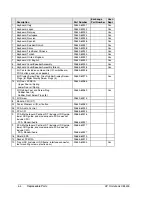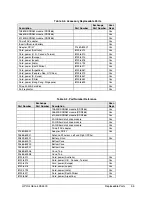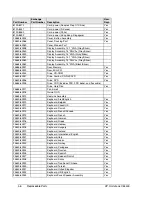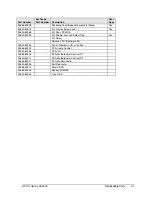
HP Omnibook XE4400
Troubleshooting and Diagnostics
3-21
Beep Codes*
POST Description
1-3-1-3
Test 8742 Keyboard Controller (on motherboard).
1-3-2-1
Set ES segment register to 4 GB.
1-3-3-1
Auto size DRAM; or wrong type or no RAM installed.
1-3-3-2
Initialize POST Memory Manager.
1-3-3-3
Clear 512 kB base RAM.
1-3-4-1
RAM failure on address line xxxx.
1-3-4-3
RAM failure on data bits xxxx of low byte of memory bus.
1-3-4-4
Enable cache before system BIOS shadow.
1-4-1-1
RAM failure on data bits xxxx of high byte of memory bus.
1-4-1-3
Test CPU bus-clock frequency.
1-4-1-4
Initialize Phoenix Dispatch Manager.
1-4-2-3
Warm start shut down.
1-4-3-1
Shadow system BIOS ROM.
1-4-3-3
Auto size cache.
1-4-4-1
Advanced configuration of chipset registers.
1-4-4-2
Load alternate registers with CMOS values.
2-1-1-2
Initialize extended memory for RomPilot.
2-1-1-3
Initialize interrupt vectors.
2-1-2-2
POST device initialization.
2-1-2-3
Check ROM copyright notice.
2-1-2-4
Initialize I20 support.
2-1-3-1
Check video configuration against CMOS.
2-1-3-2
Initialize PCI bus and devices.
2-1-3-3
Initialize all video adapters in system.
2-1-3-4
QuietBoot start (optional).
2-1-4-1
Shadow video BIOS ROM.
2-1-4-3
Display BIOS copyright notice.
2-1-4-4
Initialize MultiBoot.
2-2-1-1
Display CPU type and speed.
2-2-1-2
Initialize EISA board.
2-2-1-3
Test keyboard.
2-2-2-1
Set key click if enabled.
2-2-2-2
Enable USB devices.
2-2-3-1
Test for unexpected interrupts.
2-2-3-2
Initialize POST display service.
2-2-3-3
Display prompt "Press F2 to enter SETUP".
2-2-3-4
Disable CPU cache.
2-2-4-1
Test RAM between 512 and 640 kB.
2-3-1-1
Test extended memory.
2-3-1-3
Test extended memory address lines.
2-3-2-1
Jump to UserPatch1.
2-3-2-3
Configure advanced cache registers.
2-3-2-4
Initialize Multi Processor APIC.
2-3-3-1
Enable external and CPU caches.
2-3-3-2
Set up System Management Mode (SMM) area.
2-3-3-3
Display external L2 cache size.
2-3-3-4
Load custom defaults (optional).
2-3-4-1
Display shadow-area message.
2-3-4-3
Display possible high address for UMB recovery.
2-4-1-1
Display error messages.
2-4-1-3
Check for configuration errors.
2-4-2-3
Check for keyboard errors.
2-4-4-1
Set up hardware interrupt vectors.
2-4-4-2
Initialize Intelligent System Monitoring.
2-4-4-3
Initialize coprocessor if present.
3-1-1-1
Disable onboard Super I/O ports and IRQs.
3-1-1-2
Late POST device initialization.
3-1-1-3
Detect and install external RS232 ports.
3-1-1-4
Configure non-MCD IDE controllers.
3-1-2-1
Detect and install external parallel ports.
3-1-2-2
Initialize PC-compatible PnP ISA devices.
3-1-2-3
Re-initialize onboard I/O ports.
3-1-2-4
Configure Motherboard Configurable Devices (optional).
3-1-3-1
Initialize BIOS Data Area.
3-1-3-2
Enable Non-Maskable Interrupts (NMIs).
3-1-3-3
Initialize Extended BIOS Data Area.
3-1-3-4
Test and initialize PS/2 mouse.
3-1-4-1
Initialize floppy controller.
3-1-4-4
Determine number of ATA drives (optional).
3-2-1-1
Initialize hard-disk controllers.
3-2-1-2
Initialize local-bus hard-disk controllers.
3-2-1-3
Jump to UserPatch2.
Summary of Contents for OmniBook XE4400
Page 1: ... HP Omnibook XE4400 Technology Code KD Service Manual ...
Page 8: ......
Page 22: ......
Page 94: ...4 2 Replaceable Parts HP Omnibook XE4400 Figure 4 1 Exploded View ...
Page 100: ......
Page 105: ......
Page 106: ...Part Number F4665 90024 Printed in U S A 4 02 ...

